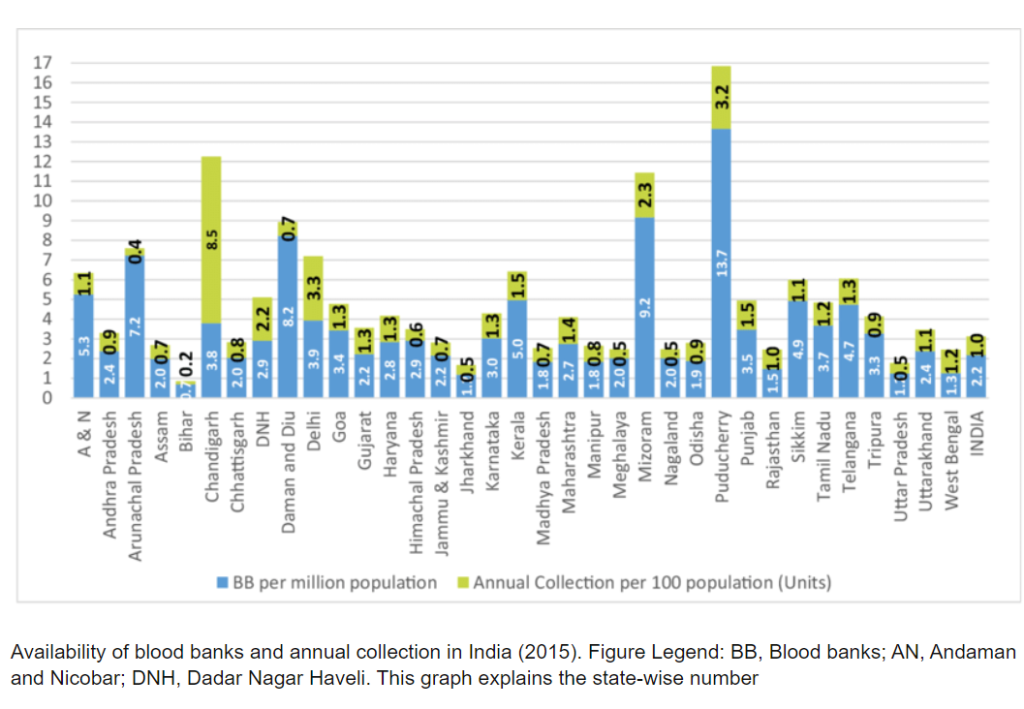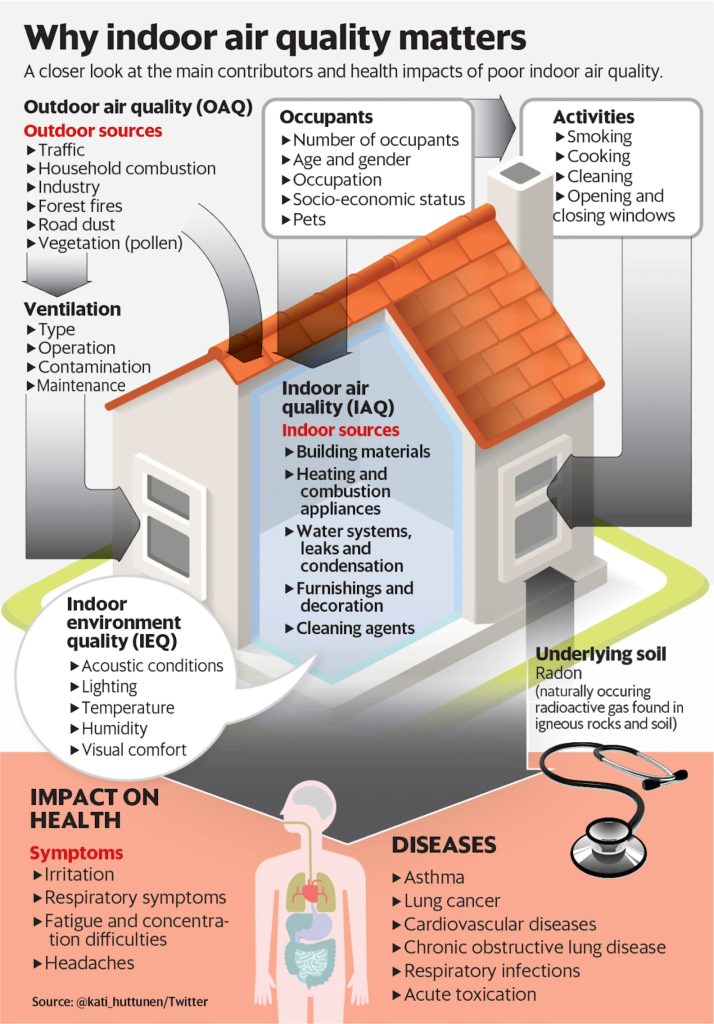CONTENTS
- The Blood Management System Needs a Fresh Infusion
- Ensuring Better Indoor Air Quality
The Blood Management System Needs a Fresh Infusion
Context:
Drawing lessons from the global disparities in public health highlighted by the COVID-19 pandemic experiences, policymakers worldwide have appropriately emphasized the necessity of enhancing the global health framework. While strategies like increased health funding, expanded utilization of digital health solutions, and improved accessibility to medical countermeasures are crucial, it is essential to prioritize access to blood and its derivatives in building a resilient global health architecture.
Relevance:
GS2- GS2- Governance- Issues relating to development and management of Social Sector/Services relating to Health.
Mains Question:
Prioritising access to blood and its products remains fundamental to building a resilient global health architecture. Evaluating the blood management system of India, suggest a way forward strategy to effectively ensure a better management of the blood in India’s health framework. (15 Marks, 250 Words).
Blood Transfusion:
As per the American Red Cross Society, blood transfusion generally involves the intravenous reception of blood or blood products. This procedure is employed for various medical conditions to replenish lost components of the blood.
Significance of Blood and its Derivatives in maintaining Patient Health:
Blood and its various derivatives play a pivotal role in numerous medical situations, including scheduled surgeries, emergency procedures, and the treatment of conditions such as cancer, thalassemia, and postpartum haemorrhage (PPH). This emphasizes their irreplaceable significance in maintaining patient health across a range of healthcare needs.
The Issue of Blood Shortage:
- The issue of blood shortage has been highlighted in a recent report from the World Health Organization (WHO), shedding light on global disparities in blood collection.
- Despite comprising 14% of the global population, countries in the WHO African region collected only 5% of global donations.
- Similar patterns were observed in low-income and lower-middle-income nations, where they received 2% and 24% of worldwide contributions, respectively, despite representing only 8% and 40% of the global population.
Blood Management in India:
Blood Transfusion System In India
The blood transfusion system in India is well-structured and regulated to ensure the safety, quality, and accessibility of blood and its components for those in need. Here is an overview:
Role of NACO: The National AIDS Control Organization (NACO) has played a pivotal role since 1992 in ensuring the provision of safe blood throughout the country
Network of Blood Banks: India boasts a network of 1131 blood banks, spread across over 600 districts, primarily supported by NACO.
National Blood Policy: Introduced by the Government of India in April 2002, this policy aims to ensure easy access to sufficient, safe, and high-quality blood.
Regulatory Body: The National Blood Transfusion Council (NBTC), established as per a Supreme Court mandate in 1996, acts as the apex policy-making body for matters related to blood and plasma.
Modernization and Quality Control: NACO has implemented various measures to modernize blood banks, ensuring the safety of the country’s blood supply.
Evaluation of the Blood Management System in India:
- Even though India has made improvements in its blood management system, the country continues to face a persistent shortage of blood units, affecting critical healthcare services.
- According to WHO’s self-sufficiency standards, India collected approximately 1.27 crore blood units in 2019-20 but experienced a shortage of over six lakh units.
- Addressing these shortages promptly is crucial as they can significantly impact the functioning of the healthcare system and contribute significantly to saving lives.
- For instance, a study by Savitribai Phule Pune University revealed that an accident victim may require up to 50 units of blood, and in 2019-20, the shortage jeopardized the lives of approximately 12,000 accident victims. Additionally, this deficit could affect around 1,00,000 heart surgeries and roughly 30,000 bone marrow transplants.
- According to data presented in Parliament, a surplus of 30 lakh blood units and related products was discarded over three years, from 2014-15 to 2016-17.
- Primary reasons included expiration from non-use, degradation during storage, and the presence of infections such as human immunodeficiency virus (HIV) and syphilis.

The Hub and Spoke Model in Access to Blood:
- The hub and spoke model features a central metro blood bank serving as the focal point for all blood testing and separation of components.
- The processed blood and its components are then distributed to smaller blood banks and blood storage centers, known as spokes.
- Addressing disparities in access to safe and sustainable blood can be achieved through the establishment of strong public-private partnerships (PPP).
- Collaborations involving key industry players have significant potential to introduce innovative models for blood collection and distribution, effectively tackling existing challenges.
- One such innovative approach is the hub and spoke model, where high-volume blood banks serve as hubs for smaller blood centers.
- This model is particularly relevant in resource-constrained settings, such as Low- and Middle-Income Countries (LMIC), as it can bridge critical gaps in blood availability and distribution, thereby improving accessibility and availability of blood and its products.
- Additionally, given the short shelf life of blood and its products, the hub and spoke model facilitates optimal utilization by smaller blood centers.
- This innovative approach streamlines distribution, ensuring that these essential resources reach their maximum potential while minimizing losses due to expiration.
- Implementing a hub and spoke model can not only address issues of blood discards and wastage but also enhance accessibility to safe blood and its products in community health centers and smaller sub-district hospitals, especially in geographically challenging terrains.
Way Forward:
- Another factor contributing to the disparities within the blood management system is the perpetuation of myths and misinformation related to voluntary blood donation.
- Many individuals still abstain from voluntarily donating blood due to concerns about infections, potential harm to their immunity, or the misconception that the process is time-consuming. Targeted awareness initiatives can dispel these misconceptions.
- While the government and its agencies have made efforts to enhance awareness through regular campaigns, the private sector can collaborate closely with the government to initiate dedicated awareness campaigns at the grassroots level.
- These campaigns can harness the influence of social media and utilize innovative tools like multilingual comics to emphasize the importance and benefits of regular and voluntary blood donation.
- Employing such creative strategies can effectively engage diverse audiences and cultivate a culture of informed and voluntary blood donation.
Conclusion:
As we move beyond the COVID-19 pandemic and align the global developmental roadmap for an equitable and sustainable future, the health paradigm must be adequately prepared. Given the central role of blood and its products in modern medicine, political leaders and policymakers must continue taking measures to strengthen the blood management ecosystem. Concurrently, proactive involvement from the industry and the active participation of citizens should be integral aspects of this coordinated effort.
Ensuring Better Indoor Air Quality
Context:
During the winter season, as the Air Quality Index declines, the issue of Indoor Air Quality (IAQ) becomes a significant concern due to its potential adverse effects on occupants’ health. Despite the prevailing outdoor pollution, individuals often prefer staying indoors to avoid exposure to high pollution levels.
Relevance:
GS3- Environment- Pollution and Conservation
Mains Question:
Recognizing the health risks associated with poor Indoor Air Quality, develop an effective roadmap at the government and individual levels to minimise the rising phenomena of indoor air pollution. (10 Marks, 150 Words).
Indoor Air Pollution:
About Indoor Air Pollution:
- The term “indoor air pollution” pertains to the introduction of dirt, dust, and gases into buildings, leading to contamination of the enclosed air.
- It encompasses the examination of the physical, chemical, and biological characteristics of the air in indoor environments, be it in homes, institutions, or commercial facilities.
- Indoor air pollution stems from various factors, both in rural and urban settings. This discrepancy arises because enclosed spaces facilitate the accumulation of potential contaminants more readily than open environments.
- Numerous air pollutants, including NOx, SO2, ozone (O3), CO, volatile and semi-volatile organic compounds (VOCs), particulate matter (PM), radon, and microorganisms, have been identified within indoor spaces.

Causes of Indoor Air Pollution:
- Some of these pollutants, such as NOx, SO2, O3, and PM, originate from external sources and are present in both indoor and outdoor settings.
- Contrary to the common belief that indoor air is safe, many are surprised to learn that it can be up to 10 times more polluted than outdoor air, primarily due to inadequate ventilation in enclosed spaces.
- In winter, when doors and windows are kept closed, the indoor air becomes trapped, leading to a rapid deterioration in air quality compared to the outdoor environment.
- This problem is exacerbated in commercial and industrial spaces with complex structures, such as healthcare facilities, construction sites, factories, hotels, airports, and offices.
- These settings often contain various indoor air pollutants, including volatile organic compounds (VOCs) from synthetic building materials, furnishings, and cleaning supplies, contributing to further degradation of indoor air.
- Additionally, the presence of humidity fosters the growth of microorganisms like mold and mildew, resulting in musty odors and adversely affecting occupants’ well-being.
Impact of Indoor Air Pollution:
- Poor Indoor Air Quality can lead to respiratory issues, eye irritation, headaches, fatigue, and other health conditions.
- These air contaminants may exhibit radioactive, organic, inorganic, or even biological characteristics. In developing nations, indoor air pollution, also known as “household air pollution,” poses a significant health risk.
- Inadequate ventilation may even cause ‘Sick Building Syndrome,’ negatively impacting overall health.
- The State Of Global Air Report 2019 indicated that approximately 846 million individuals in India encountered household air pollution in 2017. This figure represents roughly 60% of the country’s population.
Improving the Indoor Air Quality:
- Recognizing the health risks associated with poor IAQ, occupants must prioritize improving ventilation in enclosed spaces for enhanced public health.
- Installing Heating, Ventilation and Air Conditioning systems can significantly contribute to achieving optimal ventilation by ensuring a continuous supply of fresh air throughout the building.
Heating, Ventilation and Air Conditioning:
- HVAC, an acronym for Heating, Ventilation, and Air Conditioning, constitutes a series of technologies commonly employed to regulate room temperature, humidity, and ventilation within a specified area. Its purpose is to create a comfortable environment and maintain an acceptable standard of indoor air quality.
- The design and implementation of HVAC systems fall under the domain of mechanical engineering.
- The application of HVAC is rooted in the principles of thermodynamics, heat transfer, and fluid mechanics.
- These systems find utility in both residential and industrial settings, necessitating a centralized mechanism for air conditioning, heating, and ventilation.
- Key components integral to HVAC systems include:
- Heat exchanger
- Furnace chamber
- Condensing chamber
- Evaporator Coil
- Refrigerant Lines
- Ducts
- Vents
- Thermostat
- These systems bring in fresh outdoor air to dilute indoor contaminants and filter pollutants from the incoming air while removing stale air from inside.
- Moreover, HVAC systems offer thermal comfort by utilizing advanced desiccant technology to regulate indoor humidity. This helps maintain optimal relative humidity (RH), inhibiting the growth of microorganisms like mold and mildew.
- The installation of advanced Energy Recovery systems, such as Enthalpy Wheels, facilitates efficient ventilation without compromising the air conditioning load, consequently reducing operational costs.
Conclusion:
Equipped with honeycomb-designed chemical filters, HVAC systems can effectively remove gaseous contaminants from buildings. Considering the escalating impact of poor IAQ on health, alongside adopting HVAC systems, individuals should embrace Green Buildings. Utilizing green products in building construction strikes a balance between occupant comfort and reduced energy consumption, providing a sustainable approach to addressing IAQ concerns.




